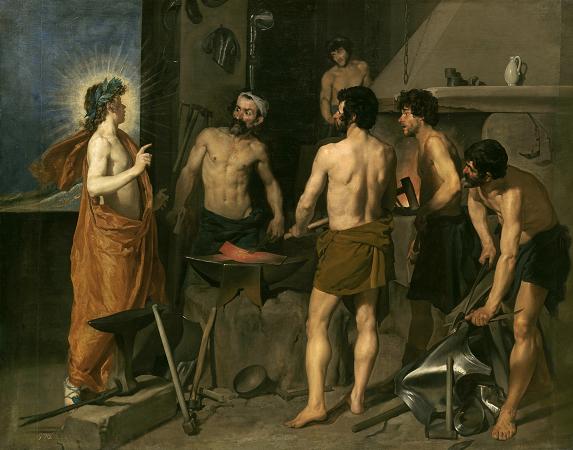
Apollo in Forge of Vulcan. Apollo in the Forge of Vulcan, sometimes referred to as Vulcan's Forge, is an oil painting by Diego de Velázquez completed after his first visit to Italy in 1629.
Critics agree that the work should be dated to 1630, the same year as his companion painting Joseph's Tunic. It appears that neither of the two paintings were commissioned by the king, although both became part of the royal collections within a short time.
The painting became part of the collection of the Museo del Prado, in Madrid, in 1819. Apollo in the Forge of Vulcan has been cited as one of the most important works from Velázquez's first trip to Italy and one of his most successful compositions with regard to the unified, natural interaction of the figures.
The painting depicts the moment when the god Apollo, identifiable by the crown of laurel on his head, visits Vulcan, who is found making weapons for war. The god Apollo tells Vulcan that his wife, Venus, is having an affair with Mars, the god of war.
For this reason, the other figures in the room are looking in surprise at the god who has just appeared before them, some of them even opening their mouths to indicate surprise. Velázquez was inspired to create this work by an engraving by Antonio Tempesta, modifying it greatly and centering the narrative action on the arrival of Apollo, using a classical baroque style. It emphasises contemporary interest in nude
Critics agree that the work should be dated to 1630, the same year as his companion painting Joseph's Tunic. It appears that neither of the two paintings were commissioned by the king, although both became part of the royal collections within a short time.
The painting became part of the collection of the Museo del Prado, in Madrid, in 1819. Apollo in the Forge of Vulcan has been cited as one of the most important works from Velázquez's first trip to Italy and one of his most successful compositions with regard to the unified, natural interaction of the figures.
The painting depicts the moment when the god Apollo, identifiable by the crown of laurel on his head, visits Vulcan, who is found making weapons for war. The god Apollo tells Vulcan that his wife, Venus, is having an affair with Mars, the god of war.
For this reason, the other figures in the room are looking in surprise at the god who has just appeared before them, some of them even opening their mouths to indicate surprise. Velázquez was inspired to create this work by an engraving by Antonio Tempesta, modifying it greatly and centering the narrative action on the arrival of Apollo, using a classical baroque style. It emphasises contemporary interest in nude
Wikipedia ...